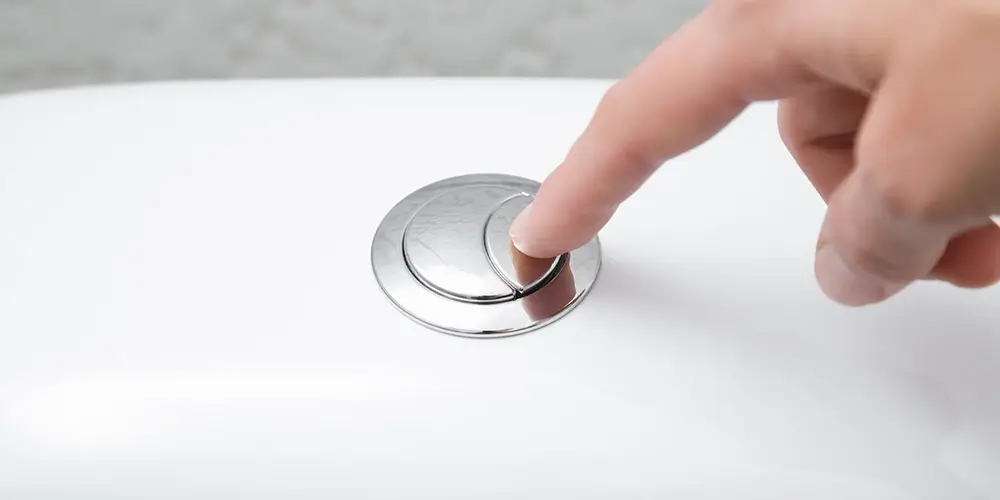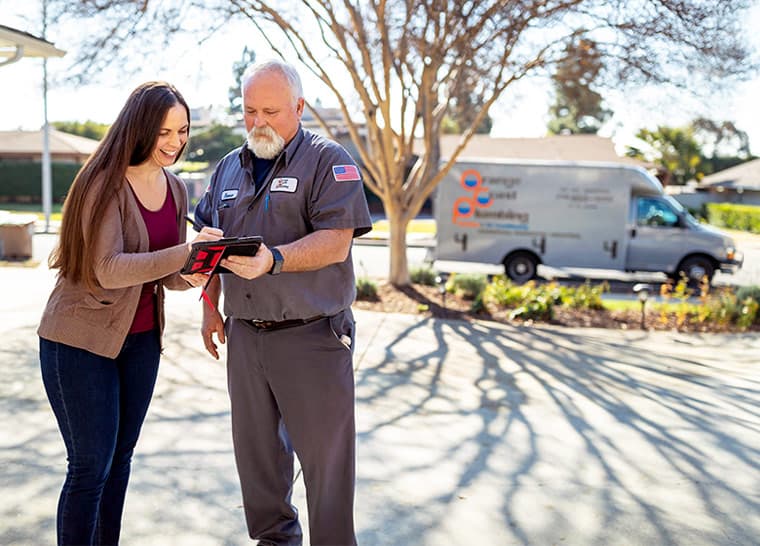What’s a Dual-Flush Toilet?
The name can be confusing. A dual-flush toilet doesn’t flush twice. It flushes less. A lot less.
A dual flush toilet has two buttons or levers to flush different amounts of water, depending on what’s being flushed. The first button or lever is for liquid waste and uses less water. The second button or lever is for solid waste and uses more water.
Benefits of a Dual Flush Toilet
A dual-flush toilet can use up to 67% less water than a standard single-flush toilet. That’s because you’re only using the amount of water necessary to do the job.
This offers obvious benefits for Southern Californians in the grip of a historic drought. Older toilets send between 3.5 and 7 gallons of water per flush into municipal sewers!
By law, newer low-flow toilets specify can use no more than 1.6 gallons of water per flush. But dual flush toilets average only about 1.28 gallons per flush. That’s the average per flush for number 1 and number 2 throughout the day — it works out to 1.28!
Why Your Dual-Flush Toilet Keeps Running Intermittently
1. Flapper or Seal Trouble
The flapper is stuck open. It’s the rubber seal covering the hole at the bottom of the tank. When you flush the toilet, it opens to let water into the bowl.
As the tank empties, the flapper lowers along with the water level, then closes to stop the water flow. Except when it doesn’t.
- If your flapper’s stuck open, water will continue running into the bowl and down the drain.
- Try jiggling the handle to reset the flapper and “remind it to do its job.”
- If that doesn’t work, you may need to replace it.
The flapper is cracked, brittle, damaged, or misaligned.
- A damaged flapper is damaged won’t form a tight seal
- A misaligned flapper may not open at all when you flush. And it won’t seal the tank as designed.
- You’ll have to replace a damaged flapper and adjust a flapper that’s out of alignment.
The seal under the flapper is brittle or damaged.
- Turn off the water supply to the toilet; flush the toilet to empty the tank.
- Remove any remaining water with a sponge or towel.
- Remove the flush valve canister (if you have one) to access the seal.
- Check for cracks in the seal. Replace the seal if it’s damaged.
- Sometimes, a bit of Vaseline can renew the seal, making it supple and functional for the time being until you can buy a new seal.
2. Chain Trouble
- The chain connecting the flapper to the flush lever may be too long or too short.
- It should be long enough for the flapper to open completely and come back under its weight.
- If the chain is too long, it can catch on something inside the tank and keep the flapper from closing. Too short, and your toilet won’t get a full flush.
3. Float Trouble
- The float valve stops the flow of water when enough has run into the tank.
- But if the float isn’t adjusted correctly, it won’t stop the water from running.
- The solution here is to adjust the float so it stops the flow when it should.
- That’s not always easy — but it’s worth trying before you call in a plumber or replace your dual-flush toilet altogether!
4. Debris in the Tank
- Debris like a rubber band, hair or dirt can block the flush valve and prevent it from closing.
- Check your tank for debris and remove it if you find any.
- You may also want to check the flapper seat for bumps, lumps or foreign objects that could interfere with its ability to seal properly.
5. Broken Zip Tie
- The fill valve in most dual flush toilets has a zip tie to keep the base of the fill valve in place.
- The toilet will run if the fill valve isn’t well secured.
- Ties can wear out or break before the toilet has reached the end of its life.
- Replace a broken zip tie with a new one. If possible, place two zip ties on the fill valve to ensure that the base doesn’t wobble, causing the leak.
Conclusion
Some toilet problems are easy to fix with a simple DIY repair. Anything beyond your DIY competence calls for a professional’s help.
If your dual-flush toilet is taking up too much of your time and energy, call us to put an end to the frustration. All Orange Coast Plumbers are licensed, certified, insured, and friendly to boot.
So call us. You’ll be glad you did.
Orange Coast Plumbing serves Southern California with quality plumbing and HVAC repair. For more information, please call 714.953.1111.
FAQ: Dual-Flush Toilet Problems
Q: Why does my dual-flush toilet keep running after flushing?
A: Continuous running water is often due to a flapper that doesn’t seal properly or an issue with the fill valve.
Q: What causes an improper flapper seal?
A: Common causes include deterioration over time, accumulation of mineral deposits, or misalignment, preventing a watertight seal.
Q: How can I fix a fill valve issue?
A: Adjust the fill valve to ensure it stops water at the correct level, or replace it if it’s faulty.
Q: Can a leak from the tank to the bowl make my toilet run constantly?
A: Yes, a slow leak from the tank into the bowl, often due to a faulty seal, can make the toilet run continuously.
5. Are there specific parts of a dual-flush toilet I should check if it keeps running?
A: Check the dual-flush mechanism’s buttons and the flush valve seal. These are unique to dual-flush toilets and can be sources of leaks.
Q: How do I adjust the water level in my dual-flush toilet tank?
A: Most models have a screw on the float arm of the fill valve that can be turned to adjust the water level in the tank.
Q: What maintenance should I perform to prevent my dual-flush toilet from running?
Q: Regular cleaning to remove mineral deposits, checking for wear and tear on the flapper and fill valve, and replacing seals can prevent issues.
Q: Why might my dual-flush toilet suddenly start running non-stop?
A: Sudden issues are often due to a dislodged flapper or seal or a problem with the dual-flush mechanism.
Q: Could the problem be with the button mechanism of my dual-flush toilet?
A: If the buttons that trigger the flush don’t fully return to their original position, they can cause the toilet to run.
Q: Can the chain connecting the flush lever to the flapper be the culprit?
A: If the chain is too tight or loose, it can prevent the flapper from sealing correctly.
Q: Can water pressure affect the functioning of my dual-flush toilet?
A: High or fluctuating water pressure can damage internal components like the fill valve, leading to continuous running.
Q: How will I know if it’s time to replace my dual-flush toilet rather than repair it?
A: If, after addressing common issues, the toilet continues to run or repairs become frequent and costly, it’s time to consider a replacement.


